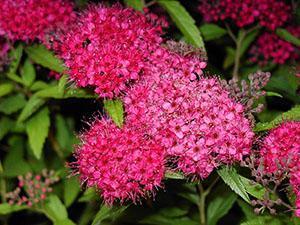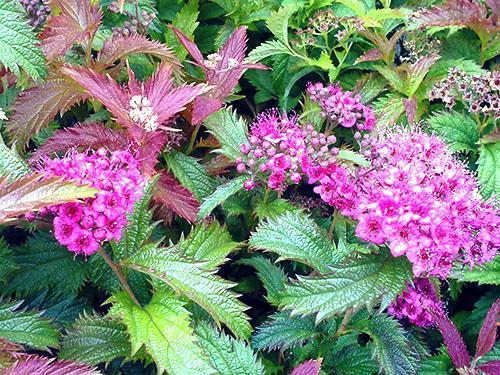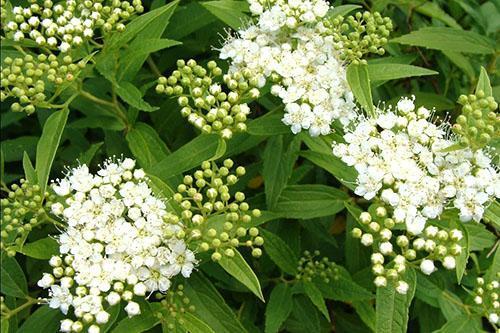Photos of popular species and varieties of spirea for landscape design
 Among the spirits, comfortably growing from the northern border of the forest to the semi-desert zone of Russia, there are about 90 species and varieties that surprise with their appearance and flowering from early spring to the onset of frost.
Among the spirits, comfortably growing from the northern border of the forest to the semi-desert zone of Russia, there are about 90 species and varieties that surprise with their appearance and flowering from early spring to the onset of frost.
Deciduous shrubs up to two meters high, depending on the variety, can have:
- different crown shape;
- color and type of inflorescences;
- the duration and timing of flowering.
It is not difficult for experienced gardeners to choose plants in such a way that white, pink and crimson spirea flowers serve as a living decoration of the site.
Focusing on the time of mass flowering, the types and varieties of spirea are divided into two groups:
- plants covered with lush inflorescences in spring;
- shrubs that bloom almost all summer.
Moreover, in the first case, flower buds are laid on one-year-old branches, while in spirales of summer flowering, the buds open on new shoots. With all the differences, these numerous types of ornamental shrubs are unpretentious and after three years they appear on the site in all their glory.
Japanese spirea (Spiraea japonica)

Shrubs from 1.2 to 2 meters in height, with a neat spherical crown and green or golden foliage, are used in the decoration of borders, in single and group plantings. Due to its winter hardiness, the ability to quickly replenish shoots even in the case of freezing and unpretentiousness of the spirea, Japanese spirea can be planted to create compact hedges.
In the crown of varieties with golden foliage, gardeners often notice powerful shoots with ordinary green foliage. To maintain the appearance of the plantings, such shoots, like the old branches of 5-6 years, are removed.
 But even with annual spring pruning and care, spirea shrubs, of all types and varieties in the photo below, require replacement after 16 or 20 years.
But even with annual spring pruning and care, spirea shrubs, of all types and varieties in the photo below, require replacement after 16 or 20 years.
Among the varieties of Japanese spirea, the most in demand are:
- Little Princess with a rounded crown about 50–65 cm high, dark green foliage and pink inflorescences that appear in June and remain attractive until August;
- Goldflame with a meter-high crown and decorative yellow foliage and medium-sized pink or red flowers;
- Golden Princess are one meter tall plants with yellow, like Goldflame, foliage and thyroid pink inflorescences;
- Macrophylla is a variety of Japanese spirea, characterized by large wrinkled leaves that turn bright yellow by autumn, among which pink flowers collected in small inflorescences are not too noticeable;
- Candlelight is a compact dwarf plant with pale yellow foliage that brightens towards mid-summer when the pink buds are in full bloom.
Spirea Vangutta (Spiraea x vanhouttei)
 This species is obtained as a result of crossing the Cantonese and three-lobed spirea plants. The Vangutta spirea bushes, growing up to two meters in height and attracting attention thanks to their beautiful spreading crown, are considered the largest in the family.
This species is obtained as a result of crossing the Cantonese and three-lobed spirea plants. The Vangutta spirea bushes, growing up to two meters in height and attracting attention thanks to their beautiful spreading crown, are considered the largest in the family.
The leaves of this type of spirea are dark green, with jagged edges of the leaves. In the fall, the foliage changes color to red or bright orange.
The massive appearance of snow-white flowers, collected in thyroid semicircular inflorescences, occurs in the second decade of June. And already in August, under favorable conditions, the plant is ready to bloom again. The shade-tolerant and fast-growing spirea Wangutta in the photo begins to bloom actively at the age of three. The plant is perfect for both group and single plantings.
Spirea Bumalda (Spiraea x bumalda)
 A hybrid, artificially bred species obtained from crossing a white-flowered and Japanese spirea, which is similar in appearance, but does not exceed 80 cm in height. The Boomald spirea bush has erect branching shoots with brightly colored foliage, especially in autumn. Already in mid-August, the leaves become yellow, crimson and scarlet. The brightest autumn foliage in the bushes that are in a sunny area. In summer, from the end of June and for a month and a half, the shrub is decorated with dense pink inflorescences.
A hybrid, artificially bred species obtained from crossing a white-flowered and Japanese spirea, which is similar in appearance, but does not exceed 80 cm in height. The Boomald spirea bush has erect branching shoots with brightly colored foliage, especially in autumn. Already in mid-August, the leaves become yellow, crimson and scarlet. The brightest autumn foliage in the bushes that are in a sunny area. In summer, from the end of June and for a month and a half, the shrub is decorated with dense pink inflorescences.
Among the popular varieties of Bumald's spirea:
- Anthony Waterer, adorned with vibrant reds throughout the summer and looks great in single plantings as well as when organizing large flower beds;
- Dart's Red is a shrub of half a meter in height with erect shoots, on which leaves with a pink tint bloom in spring, turning green in summer and acquiring a deep red color in autumn.
Spirea gray (Spiraea x cinerea)
 Spectacular gray spirea is a hybrid plant that does not occur in the wild. The bush has graceful drooping shoots from one and a half to two meters high. During the flowering period, they are strewn with white flowers on corymbose inflorescences. The plant got its name thanks to the lanceolate leaves, which have an unusual silvery-green color. Flowering begins in mid-May and lasts up to one and a half months.
Spectacular gray spirea is a hybrid plant that does not occur in the wild. The bush has graceful drooping shoots from one and a half to two meters high. During the flowering period, they are strewn with white flowers on corymbose inflorescences. The plant got its name thanks to the lanceolate leaves, which have an unusual silvery-green color. Flowering begins in mid-May and lasts up to one and a half months.
The fruits appear on the branches in July, but they cannot be used in plant propagation. The hybrid species reproduces only by cuttings. And already in the third or fourth year after planting, young bushes of gray spirea begin to bloom.
Spiraea nippon (Spiraea nipponica)
 This type of spirea comes from plants from the Japanese islands. The nippon spirea has a spherical crown shape, reaching two meters in diameter. The bush is dense with horizontally directed branches and small oval green leaves. Flowering begins at the end of May or June and lasts about a month. The inflorescences, scabiform, densely covering the shoots, consist of white or yellowish flowers. In this case, unopened buds can be painted pink or purple.
This type of spirea comes from plants from the Japanese islands. The nippon spirea has a spherical crown shape, reaching two meters in diameter. The bush is dense with horizontally directed branches and small oval green leaves. Flowering begins at the end of May or June and lasts about a month. The inflorescences, scabiform, densely covering the shoots, consist of white or yellowish flowers. In this case, unopened buds can be painted pink or purple.
Spirea nippon is ideal for single plantings. The plant is not demanding on the soil, but loves well-lit areas.
Russian gardeners have a popular variety Halward's Silver about a meter high and large white inflorescences. Summer residents like the tall, up to two meters in height Snowmound with elongated leaves and snow-white flowers.
Spirea Douglas (Spiraea douglasii)
 The unpretentious North American species of spirea forms a one and a half meter bush with pubescent, straight shoots with a red-brown bark. Flowering begins at the age of three, falls in July and continues until autumn.
The unpretentious North American species of spirea forms a one and a half meter bush with pubescent, straight shoots with a red-brown bark. Flowering begins at the age of three, falls in July and continues until autumn.
The leaves of the Douglas spirea are oblong, lanceolate, evenly cover the erect shoots, on the tops of which there are fluffy pink inflorescences of a narrow pyramidal shape.
Spirea willow (Spiraea salicifolia l.)
 The two-meter willow spirea lives in a number of regions of Siberia, in the European territory of Russia and in the countries of the Far East. In the wild, shrubs with straight shoots covered with red-brown bark are found in swampy areas of river floodplains, along the shores of lakes and forest channels.
The two-meter willow spirea lives in a number of regions of Siberia, in the European territory of Russia and in the countries of the Far East. In the wild, shrubs with straight shoots covered with red-brown bark are found in swampy areas of river floodplains, along the shores of lakes and forest channels.
The plant has sharp-pointed leaves, excised at the edges, reaching 10 cm in length, and flowers collected in paniculate or pyramidal inflorescences are pink or white.Spirea willow bushes tolerate winters well, love moist, loose soils and sufficient lighting. It can be propagated by cuttings or seeds. And the mass flowering occurs in the fourth year of the life of the decorative culture.
Spiraea Billard (Spiraea x billardii)
 Billard's vigorous spreading spirea is a hybrid form, the result of artificial crossing of willow spirea and Douglas spirea. The crown, up to 2 meters in diameter, is covered with jagged oblong ten-centimeter leaves, covered with silvery hairs on the back.
Billard's vigorous spreading spirea is a hybrid form, the result of artificial crossing of willow spirea and Douglas spirea. The crown, up to 2 meters in diameter, is covered with jagged oblong ten-centimeter leaves, covered with silvery hairs on the back.
The flowers of this spectacular species are bright pink and open in the second half of July. They form panicle inflorescences that adorn the bush until the cold weather, which the spirea can easily tolerate. It is easy to propagate a spirea of this species, which does not produce fruit, with the help of cuttings. At the same time, sunny areas with moderately nutritious soil are suitable for planting.
For Billard's spirea, spring pruning is desirable, stimulating the emergence of young shoots and the development of new flower buds.
Spirea Arguta (Spiraea x. Arguta)
 A tall, spreading bush of 2 meters in height with drooping branches, from May covered with white inflorescences in the form of semicircular caps, is one of the early flowering hybrid species of spirea. The buds bloom at the end of May, and until the middle of June the Argut spirea is a spectacular sight. From under the mass of flowers, dark green lanceolate leaves with jagged edges are practically invisible.
A tall, spreading bush of 2 meters in height with drooping branches, from May covered with white inflorescences in the form of semicircular caps, is one of the early flowering hybrid species of spirea. The buds bloom at the end of May, and until the middle of June the Argut spirea is a spectacular sight. From under the mass of flowers, dark green lanceolate leaves with jagged edges are practically invisible.
Flowering takes place on the branches of the previous year, which are pruned after the inflorescence wilting. The best place for an Argutta spirea is in the center of a flower garden or hedge. It is important to take into account the low growth rate of these plants.